Huawei MateBook X Pro (2021) Review: A Sleek and Vibrant Notebook
by Dr. Ian Cutress on September 28, 2021 9:00 AM EST- Posted in
- Notebooks
- Intel
- Huawei
- Laptops
- Matebook X Pro
- Tiger Lake
Display
On paper, the specifications for the Huawei MateBook X Pro 2021 seem impressive – a 3000x2000 resolution LTPS display that gives a 91% screen-to-body ratio. At a 13.9-inch diagonal, that translates to 260 pixels per inch, which is a key target for devices in this price bracket. Huawei rates the display as a 450 nit brightness with a 1500:1 contrast ratio, which is above a lot of traditional 300 nit displays that sometimes plague this price point. On top of this, Huawei promotes a 100% sRGB gamut for color accuracy, and the screen supports 10-point multi-touch as well as gestures.
As mentioned a few pages prior, because Huawei has moved the webcam from the display to the keyboard, this allows the display to go as far up to the edge of the chassis as Huawei could make it without sacrificing rigidity. Any laptop looks really good when a display almost touches the edge, which when combined with the 450 nit brightness does make the device stand out.
The panel is listed as the Tianma XM TL139GDXP01, and the official specifications match those Huawei has provided.
For our testing today, we’re using the X-Rite i1Display Pro colorimeter.
Brightness and Contast
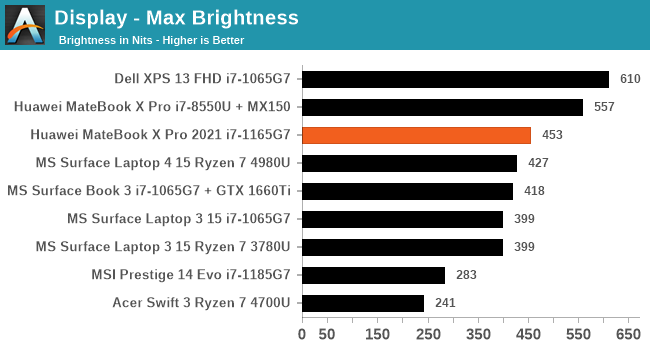
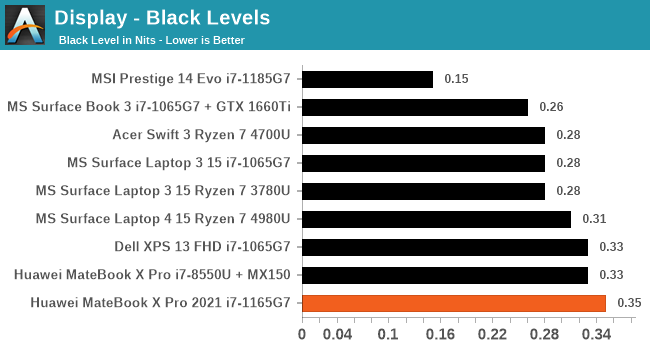

As for maximum brightness, we’re right on specification, however in our testing the black level is certainly higher than other devices in the market, which leads to a lower-than-advertised contrast ratio.
Battery Life
Taking advantage of the bigger-than-13-inch form factor, Huawei has equipped the MateBook X Pro 2021 with a 56 Wh battery, which is about 10-20% bigger than the 45 Wh batteries we see in the smaller size. Without the presence of a discrete GPU, one might argue that this battery should go for a long time, however the high-resolution display might prove to be an Achilles heel. Huawei’s documentation lists a 10 hour battery life for local video playback, which would be just enough for a long haul flight.
For our testing, we calibrate the display as close to 200 nits as we can (in this case, brightness set to 62), and progress through both a movie workload and a web workload. We would have also tested using PCMark’s battery test, however the test would always fail when video decoding, as mentioned previously.
It’s worth noting that Huawei lists the battery as 56 Wh (typical). Our battery reported 55.4 Wh when fully charged.
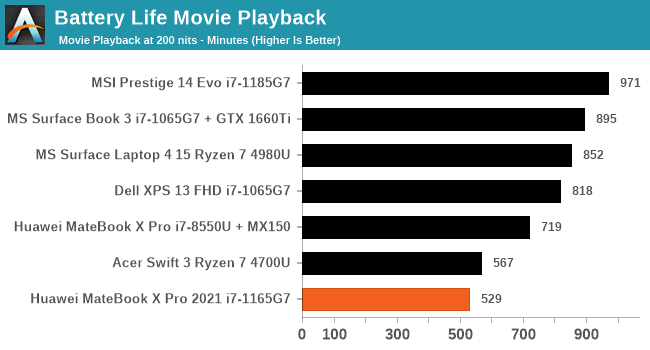
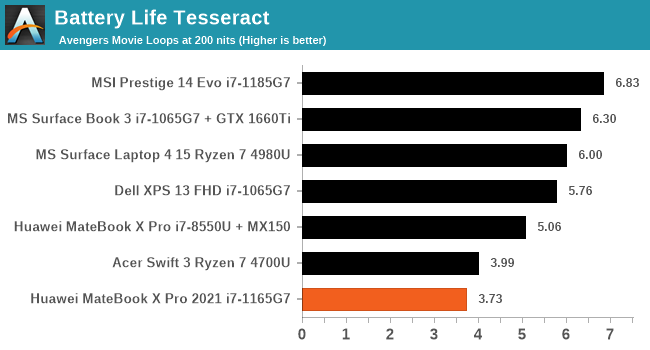
Our movie test at 200 nits is just below the 10 hour mark quoted, however Huawei seems to have done their testing at 150 nits, according to the website. 529 minutes is actually quite low compared to a number of laptops that the MateBook X Pro 2021 competes against.
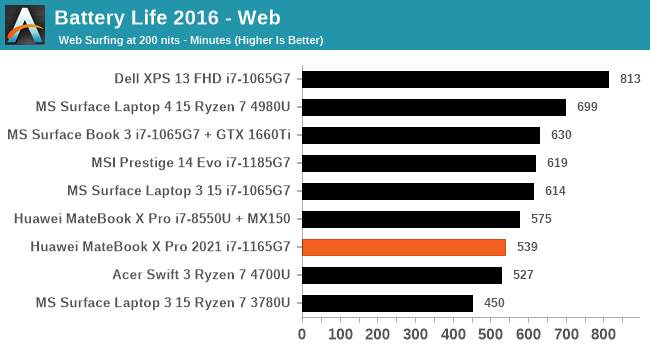
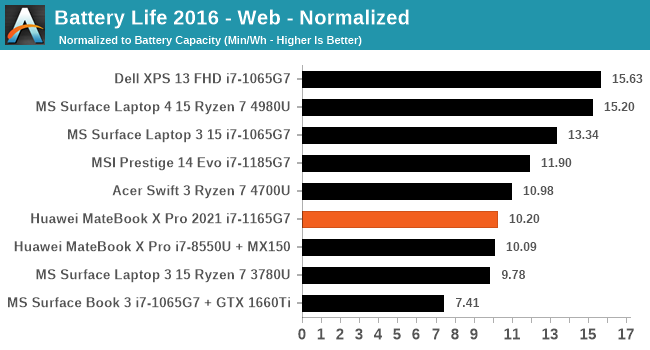
The web test does slightly better than our movie test, even though the screen is doing a lot more whites, but it isn’t having to process so much video. Normalizing for the battery capacity, we get 10.2 minutes per Watt-hour, which again isn’t a great result compared to the previous generation hardware or AMD’s offering.
Charge Time
Huawei ships the laptop with a 65 W charger with a Type-C port, and a C-to-C cable to connect it to the laptop. For our charge test, we discharge the battery down to 5% with a high powered workload, then down to 2% while on idle to cool it down. The system is then plugged it in, set on low power, with the screen still at 200 nits, and then monitored the charge level as reported as a function of time up until the reported charge no longer moved.
As well as our output report, I also put one of these in the loop. It showcased that the laptop was charging around 48-52 W constantly for the first 80 minutes or so, at 20 V / 2.5 A.
For our charge profile, we achieved:
- 2% to 10% charge in 7 minutes
- 2% to 65% charge in 60 minutes
- 2% to 90% charge in 87 minutes
- 2% to 100% charge in 110 minutes
Even though the charger is listed as 65 W capable, I didn’t see it ever go up to 65 W.
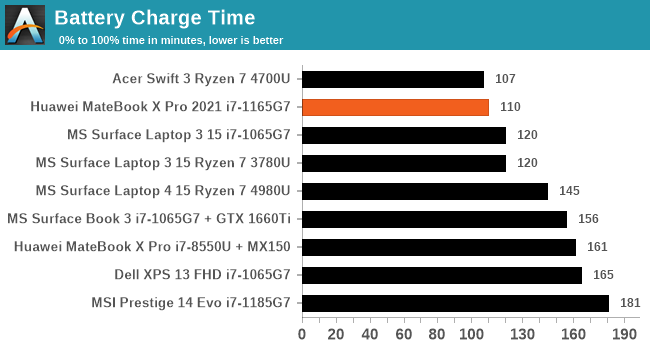


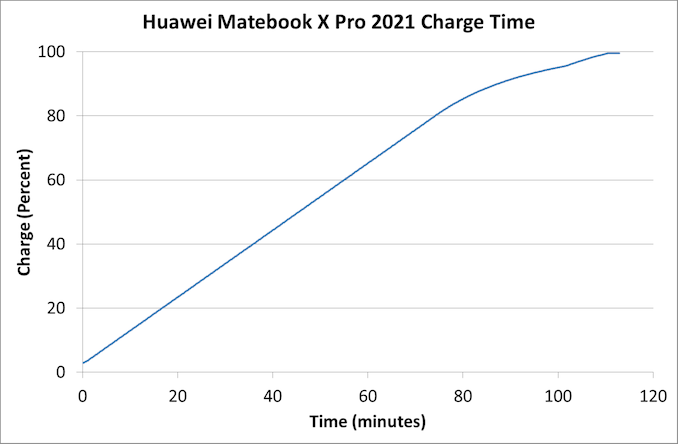








84 Comments
View All Comments
star-affinity - Saturday, October 2, 2021 - link
What? The MacBook's with their all-aluminum enclosure are more fragile than X1C?gund8912 - Monday, October 4, 2021 - link
I am still using my 2015 MBP with 5 hours battery life, any windows laptop from 2015 would have 10 mins battery life with fan running at full speed like a jet engine.MobiusPizza - Wednesday, September 29, 2021 - link
Mac OS is a different ecosystem altogether. An average consumer who is looking for Windows laptop will not naturally go and look at Mac Books, just like an average consumer looking at Mac Books will not naturally go and compare with Windows laptops.So any detailed comparison between the two is moot. It's much better to compare in the same ecosystem.
lmcd - Thursday, September 30, 2021 - link
Not much of a bite, you failed to refute the core problem with the prior post. No one is working on a single monitor in a corporate environment and also being specced out a brand-new $1000+ laptop.Where on earth have you been?
sibuna - Thursday, September 30, 2021 - link
This clearly isn't true. New deployments for us are a single 22" monitor. and an HP zbook CAD/standard depending on role.sibuna - Wednesday, September 29, 2021 - link
laptops being used 95% at a desk is prob an understatement, its prob closer to 99%. All we issue is laptops unless its going into a lab. they are almost always docked and if they are not actually docked someone is using one someplace else plugged into the wall. About the only time they are not is in meetings for an hour or so doing a presentation.the other great point is ya a MPA is not powering 2-3 displays when docked like basically every windows laptop does
markiz - Friday, October 1, 2021 - link
Any particular reason you don't deploy desktops then? Give laptops only to those that travel and work from home?star-affinity - Saturday, October 2, 2021 - link
” Macs are *horrible* to use in a corporate environment.”Are they?
It's not early 21st century anymore. :)
Yet I've been dealing with Macs in a corporate environment during this time, and it has been that bad despite many web based business tools requiring the use of Internet Explorer. Citrix and Microsoft Remote Desktop has helped. Well, those days are gone. Heck, even Internet Explorer isn't much of a thing anymore. :)
At least it depends on what software tools the corporate environment you're using – you definitely can have a corporate environment where Macs work well. You can have a corporate environment without relying on Microsoft products at all just as well has you can have a corporate environment that use a lot of Microsoft products.
dandar - Tuesday, September 28, 2021 - link
Hardly anyone cross-shops windows laptops with macbooks. Direct competitor is Dell XPS or HP Envy. I'd pick either of those over this XPS13 knock-off anyday.Operandi - Tuesday, September 28, 2021 - link
Our team works in enterprise and actually does have a mix of Macbooks and Windows (HP mostly) machines but I agree thats probably not very common. And to really be able to do anything most of us need access to Windows tools so that usually means a VDI.I really like the look of this Huawei. Seems to hit on most of the things I really look for, build quality, keyboard, and display.